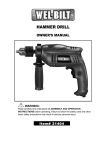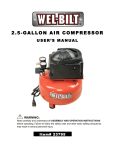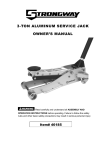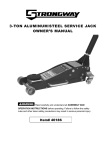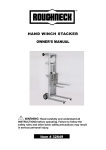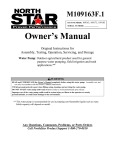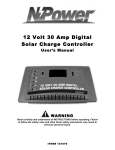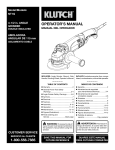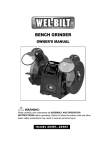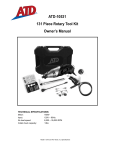Download Wel-Bilt 18649 Owner`s manual
Transcript
131-PC. ROTARY TOOL KIT OWNER’S MANUAL WARNING: Read carefully and understand all ASSEMBLY AND OPERATION INSTRUCTIONS before operating. Failure to follow the safety rules and other basic safety precautions may result in serious personal injury. Item# 18649 Thank you very much for choosing a Wel-Bilt™ product! For future reference, please complete the owner’s record below: Model: _______________ Purchase Date: _______________ Save the receipt, warranty and these instructions. It is important that you read the entire manual to become familiar with this product before you begin using it. This machine is designed for certain applications only. The distributor cannot be responsible for issues arising from modification. We strongly recommend this machine not be modified and/or used for any application other than that for which it was designed. If you have any questions relative to a particular application, DO NOT use the machine until you have first contacted the distributor to determine if it can or should be performed on the product. For technical questions please call 1-800-222-5381. INTENDED USE: The Rotary Tool has been designed with the hobbyist in mind and is ideal for intricate work or creative projects. A variety of applications including engraving, grinding, cleaning, polishing, sanding, cutting, carving and drilling can be performed with the Rotary Tool. Its flexible drill shaft is ergonomic and allows greater control over the tool. It is intended for DIY only. TECHNICAL SPECIFICATIONS: Motor: Input: No load speed: Collet chuck capacity: 160W 120V ~ 60Hz 8,000 – 35,000 RPM 1/8in. GENERAL SAFETY RULES WARNING: Read and understand all instructions. Failure to follow all instructions listed below may result in serious injury. CAUTION: Do not allow anyone to operate or assemble this Rotary Tool until they have read this manual and have developed a thorough understanding of how the Rotary Tool works. WARNING: The warnings, cautions, and instructions discussed in this instruction manual cannot cover all possible conditions or situations that could occur. It must be understood by the operator that common sense and caution are factors which cannot be built into this product, but must be supplied by the operator. SAVE THESE INSTRUCTIONS Page 2 of 11 WORK AREA Keep work area clean, free of clutter and well lit. Cluttered and dark work areas can cause accidents. Do not use your tool where there is a risk of causing a fire or an explosion; e.g. in the presence of flammable liquids, gasses, or dust. Power tools create sparks, which may ignite the dust or fumes. Keep children and bystanders away while operating a power tool. Distractions can cause you to lose control, so visitors should remain at a safe distance from the work area. Be aware of all power lines, electrical circuits, water pipes and other mechanical hazards in your work area, particularly those hazards below the work surface hidden from the operator’s view that may be unintentionally contacted and may cause personal harm or property damage. Be alert of your surroundings. Using power tools in confined work areas may put you dangerously close to cutting tools and rotating parts. ELECTRICAL SAFETY WARNING: Always check to ensure the power supply corresponds to the voltage on the rating plate. Do not abuse the cord. Never carry a portable tool by its power cord, or yank tool or extension cords from the receptacle. Keep power and extension cords away from heat, oil, sharp edges or moving parts. Replace damaged cords immediately. Damaged cords may cause a fire and increase the risk of electric shock. Grounded tools must be plugged into an outlet properly installed and grounded in accordance with all codes and ordinances. Never remove the grounding prong or modify the plug in any way. Do not use any adapter plugs. Check with a qualified electrician if you are in doubt as to whether the outlet is properly grounded. Double insulated tools are equipped with a polarized plug (one blade is wider than the other). This plug will fit in a polarized outlet only one way. If the plug does not fit fully in the outlet, reverse the plug. If it still doesn’t fit, contact a qualified electrician to install a polarized outlet. Do not change the plug in any way. Avoid body contact with grounded surfaces such as pipes, radiators, ranges, and refrigerators. There is an increased risk of electric shock if your body is grounded. When operating a power tool outside, use an outdoor extension cord marked “W-A” or “W.” These cords are rated for outdoor use and reduce the risk of electric shock. Extension Cord Use: A. Use only ‘Listed’ extension cords. If used outdoors, they must be marked “For Outdoor Use.” Those cords having 3-prong grounding type plugs and mating receptacles are to be used with grounded tools. B. Replace damaged or worn cords immediately. C. Check the name plate rating of your tool. Use of improper size or gauge of extension cord may cause unsafe or inefficient operation of your tool. Be sure your extension cord is rated to allow sufficient current flow to the motor. For the proper wire gauge for your tool, see chart. CHART FOR MINIMUM WIRE SIZE OF EXTENSION CORD: Nameplate AMPS CORD LENGTH 0-6 25’ 18 AWG Page 3 of 11 50’ 16 AWG 100’ 16 AWG 150’ 14 AWG 6-10 10-12 12-16 If in doubt, use larger cord. 18 AWG 16 AWG 14 AWG 16 AWG 16 AWG 12 AWG 14 AWG 12 AWG 14 AWG 12 AWG (NOT RECOMMENDED) Be sure to check voltage requirements of the tool to your incoming power source. Do not expose power tools to rain or wet conditions. Water entering a power tool will increase the risk of electric shock. Do not let your fingers touch the terminals of plug when installing to or removing from the outlet. Ground fault circuit interrupters. If work area is not equipped with a permanently installed Ground Fault Circuit Interrupter outlet (GFCI), use a plug-in GFCI between power tool or extension cord and power receptacle. PERSONAL SAFETY Stay alert, watch what you are doing and use common sense when operating a power tool. Do not use a power tool while you are tired or under the influence of drugs, alcohol or medication. A moment of inattention while operating power tools may result in serious personal injury. Dress properly. Do not wear loose clothing, dangling objects, or jewelry. Keep your hair, clothing and gloves away from moving parts. Loose clothes, jewelry or long hair can be caught in moving parts. Air vents often cover moving parts and should be avoided. Use safety apparel and equipment. Use safety goggles or safety glasses with side shields which comply with current national standards, or when needed, a face shield. Use as dust mask in dusty work conditions. This applies to all persons in the work area. Also use non-skid safety shoes, hardhat, gloves, dust collection systems, and hearing protection when appropriate. Avoid accidental starting. Do not carry the power tool with your finger on the switch. Ensure the switch is in the off position before plugging tool into power outlet. In the event of a power failure, while a tool is being used, turn the switch off to prevent surprise starting when power is restored. Do not overreach. Keep proper footing and balance at all times. Remove adjusting keys or wrenches before connecting to the power supply or turning on the tool. A wrench or key that is left attached to a rotating part of the tool may result in personal injury. ROTARY TOOL USE AND CARE Do not force the tool. Tools do a better and safer job when used in the manner for which they are designed. Plan your work, and use the correct tool for the job. Do not modify the Rotary Tool in any way. Unauthorized modification may impair the function and/or safety and could affect the life of the equipment. There are specific applications for which Rotary Tool was designed. Never use a tool with a malfunctioning switch. Any power tool that cannot be controlled with the switch is dangerous and must be repaired by an authorized service representative before using. Always check of damaged or worn out parts before using the Rotary Tool. Broken parts will affect the Rotary Tool operation. Replace or repair damaged or worn parts immediately. Disconnect power from tool and place the switch in the locked or off position before servicing, adjusting, installing accessories or attachments, or storing. Such preventive safety measures reduce the risk of starting the power tool accidentally. Secure work with clamps or a vise instead of your hand to hold work when practical. This safety precaution allows for proper tool operation using both hands. Page 4 of 11 Store idle tools. When tools are not is use, store them in a dry, secure place out of the reach of children. Inspect tools for good working condition prior to storage and before re-use. Use only accessories that are recommended by the manufacturer for your model. Accessories that may be suitable for one tool may create a risk of injury when used on another tool. Use only accessories (such as grinding discs) with a minimum rated of at least 35,000 RPM. Do not apply too much pressure when grinding, cutting, etc. Keep your hands well clear of the cutting devices. Keep guards in place and in working order. Never leave tool running unattended. Do not use the accessories in this kit on other rotary tools with a maximum rated no load speed more than 35,000 RPM. OPERATION: 1. Collet 2. Collet nut 3. Shaft collar 4. Spindle lock 5. Accessible brushes 6. Variable speed dial 7. Hanging ring Page 5 of 11 8. On/off switch 9. Locking chuck (flexible shaft) 10. Spindle lock (flexible shaft) 11. Handle (flexible shaft) 12. Fitting collar (flexible shaft) ON / OFF SWITCH WARNING! Before connecting a tool to a power supply be sure that the voltage supply is the same as that specified on the nameplate of the tool. A power supply with a voltage greater than that specified for the tool can result in serious injury to the user, as well as damage to the tool. If in doubt, do not plug in the tool. Using a power supply with a voltage less than the nameplate rating is harmful to the motor. • To switch on, set the variable speed dial (6) to 1 and push the on/off switch (8) to “I”. • To switch off, reset the variable speed dial (6) to 1 and push the on/off switch (8) to position “0”. VARYING THE SPEED The speed of the tool can be regulated by adjusting the variable speed dial (6); for the lowest speed adjust the dial to the number 1, for full speed adjust the dial to MAX. Low Speed Use: Certain materials (some plastics) require a relatively low speed because at high speed the friction of the tool generates heat and causes the plastic to melt. Slow speeds are usually best for polishing applications and delicate projects such as fragile model parts. It is recommended that the various shape grinding stones be used at a low speed to prevent them from becoming too hot and deteriorating. High Speed Use: Higher speeds are better for carving and shaping materials. Metal and glass projects require high speed drilling should also be done at high speed. CAUTION: Placing excessive load on the rotary tool while it is running at low speeds may cause it to overheat and the motor to fail. Note: Do not put the machine down while the motor is still running. Do not place the machine on a dusty surface, as dust particles may enter the machine. HOLDING THE TOOL • Small milling cutters/grinders pencils - high speed For jobs such as milling or engraving where precision is required, hold the mini-drill like a pen. • Large milling cutters/grinders pencils - low speed For heavier work like cutting or grinding hold the machine in the palm of your hand. CHANGING ACCESSORIES 1. Make sure that the machine is switched off and the plug removed from the power before you change any accessories. 2. Press and hold down the spindle lock button (4) and unscrew the collet nut (2). 3. Loosen and collet nut (2) fully using the 2-in-1 Wrench provided. 4. Select a suitable Collet for the accessory to be used and insert it in the collet nut shaft. 5. Insert the selected accessory into the collet. 6. Tighten collet nut (2) fully using the 2-in-1 Wrench provided. (Always ensure bits are tight Page 6 of 11 before commencing any work with your tool). LOCATING A CUTTING/SANDING DISC 1. Locate the disc holder in the collet nut (2). 2. Remove the screw from the end of the disc holder with the 2-in-1 wrench provided, and insert the screw through the cutting disc. 3. Replace the screw and cutting disc then tighten the cutting disc onto the holder. (Do not over-tighten) LOCATING A SANDING DRUM 1. Loosen the small screw in the top of the sanding drum holder. This allows the rubber to slacken. 2. Slide the sanding drum onto the holder. 3. Secure the sanding drum in place by tightening the screw causing the rubber drum to bulge and grip the drum. Do not over tighten. FLEXIBLE SHAFT INSTALLATION: 1. Remove the Shaft Collar (3). 2. Hold the handle (11) of the flexible shaft in one hand and the fitting collar (12) of the flexible shaft in your other hand. 3. Raise the handle (11) end of the flexible shaft and shake gently. This will assist the flexible shaft to become detached from the outer shaft and protrude from the fitting collar. See Figure 1. Figure 1 4. Loosen the collet nut (2) on your Rotary tool and insert the inner flexible shaft into the collet (1) and tighten the collet nut (2) with the 2 in 1 wrench. 5. Hold the rotary tool in one hand and the flexible shaft fitting collar in the other and let the other end of the flexible shaft hang down freely. 6. Gently shake the Rotary Tool and flexible shaft and screw the flexible shaft fitting collar (12) onto your Rotary Tool. Gently shaking your Rotary Tool and shaft will assist the inner flexible shaft to locate correctly in the handle (11) of the flexible shaft assembly. 7. Tighten the collet nut (2) fully using the spanner provided. Always ensure bits are tight before commencing any work with your tool. 8. Tighten the flexible shaft fitting collar onto your Rotary tool but do not over tighten. Your Flexible shaft is now ready for use. Page 7 of 11 It is recommended that you never bend the flexible shaft any smaller than 5 in. in diameter. (Fig.2) Bending the flexible shaft any tighter than 5 in. will cause the inner shaft to bind, causing additional load on your tool. Additional load could cause the tool to overheat and the motor to fail or burn out. Motor burnout caused by this action will not be covered under warranty. LED LIGHT ATTACHMENT INSTALLATION: 1. Insert the base of the LED light attachment into the slot on the top of the tool body. 2. The base of the LED light attachment is with magnet. It can be attached on any metal workpiece during operation. 3. Turn on the light by turning the head of the light clockwise. Turn off the light by turning the head of the light counterclockwise. 4. This light uses a 3 x LR41 button cell as its power supply. If you want to change the batteries, turn the head of the light anti-clockwise until the head goes off. Take out the white insert that holds the batteries and change them to the new batteries. Please be sure to insert the batteries into the white insert by the “+” face up. MAINTENANCE • Maintain your Rotary Tool. It is recommended that the general condition of any Rotary Tool be examined before it is used. Keep your Rotary Tool in good repair by adopting a program of conscientious repair and maintenance. Have necessary repairs made by qualified service personnel. • Cleaning 1. Keep the ventilation vents of the tool clean at all times, if possible, prevent foreign matter from entering the vents. 2. After each use, blow air through the tool housing to ensure it is free from all dust particles which may build up. Buildup of dust particles may cause the tool to overheat and fail. 3. If the enclosure of the tool requires cleaning, do not use solvents but a moist soft cloth only. Never let any liquid get inside the tool; never immerse any part of the tool into a liquid. Page 8 of 11 CAUTION: Do not use cleaning agents to clean the plastic parts of the tool. A mild detergent on a damp cloth is recommended. Water must never come into contact with the tool. • Repairs 1. Only an authorized Electrician or service technician should replace the cord set or make other repairs. If the cord set is damaged or worn, have it repaired or replaced by an authorized Electrician or service technician. 2. When the brushes are worn, the tool may not work. Have new brushes fitted by an authorized Electrician or service technician. Carbon brushes When the carbon brushes wear out the tool will spark and/or stop. Discontinue use as soon as this happens. They should be replaced prior to recommencing use of the tool. Carbon brushes are a wearing component of the tool therefore not covered under warranty. Continuing to use the tool when carbon brushes need to be replaced may cause permanent damage to the tool. Carbon brushes will wear out after many uses but when the carbon brushes need to be replaced take the tool to an electrician or a power tool repairer for a quick and low cost replacement. Always replace both carbon brushes at the same time. Page 9 of 11 DIAGRAM AND PARTS LIST Part list Part# 1 2 3 4 5 6 7 8 9 10 Description Collet nut Collet Nose cap Spindle lock button Ø8 base (cu) Bearing Fan Rotor Right housing Brush Qty. 1 1 1 1 1 2 1 1 1 2 Part# 11 12 13 14 15 16 17 18 19 20 Description Screw Speed control knob Stator Speed control board Switch Hanger Cord sleeve Plug Cord Left housing For replacement parts and technical questions, please call 1-800-222-5381. Page 10 of 11 Qty. 6 1 1 4 1 1 1 1 1 1 WARNING Some dust created by power sanding, sawing, grinding, drilling, and other construction activities contains chemicals known to the State of California to cause cancer, birth defects or other reproductive harm. Some examples of these chemicals are: • lead from lead-based paints, • crystalline silica from bricks and cement and other masonry products, and • arsenic and chromium from chemically treated lumber. Your risk from these exposures varies, depending on how often you do this type of work. To reduce your exposure to these chemicals: work in a well-ventilated area, and work with approved safety equipment, such as those dust masks that are specially designed to filter out microscopic particles. Distributed by Northern Tool + Equipment Company, Inc. Burnsville, Minnesota 55306 NorthernTool.com Made in China Page 11 of 11












